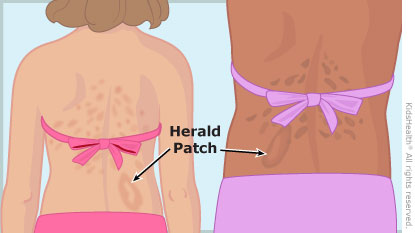Pityriasis rosea (pit-ih-RYE-uh-sis ROE-zee-uh) is a harmless rash that usually starts on the chest, abdomen, or back as one large patch (the "herald" patch). After a week or two, many smaller scaly oval spots develop and spread equally on both sides of the body. It often forms a pattern that looks like a Christmas tree. Sometimes it spreads to the arms and legs, and it can be mildly itchy.



Your child:

What causes pityriasis rosea? Its cause isn't known for sure, but researchers think it may be related to a virus. The rash itself is not contagious, though.
How long will the rash last? The rash can last for 4 to 6 weeks or even longer. In some people, it can take months to go away. On someone with light skin, the rash looks pink or red. On someone with darker skin, it might be purple, brown, or gray. Kids with darker skin tones may have temporary brown spots after the rash is gone. Pityriasis rosea doesn't leave scars and most kids don't get it again.
Can sunlight help treat pityriasis rosea? Sun exposure tends to help the rash clear up faster, but children should avoid getting a sunburn or becoming overheated, both of which can make the rash worse.